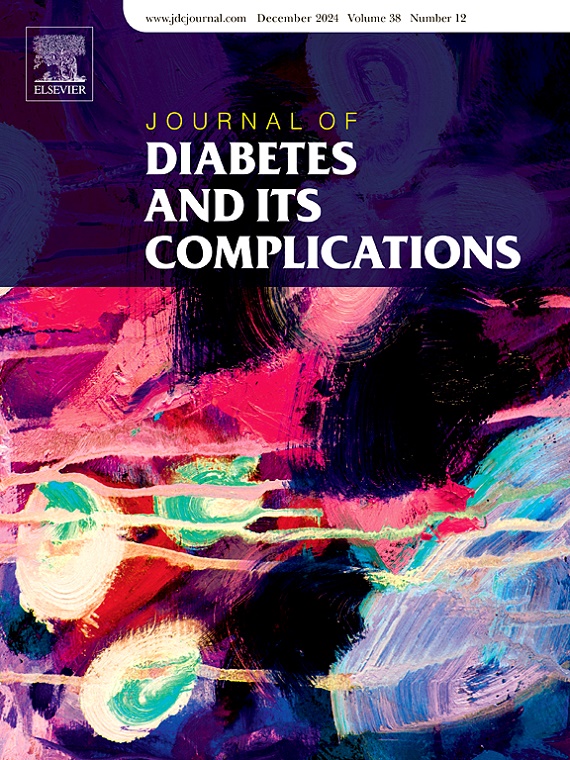Impact of remnant cholesterol and triglycerides on diabetes foot and disease in type 1 diabetes: A propensity score-matched case-control study
IF 3.1
3区 医学
Q3 ENDOCRINOLOGY & METABOLISM
引用次数: 0
Abstract
Objective
Remnant cholesterol is an emerging cardiovascular risk factor; however, its impact on diabetes foot disease (DFD) remains poorly studied. This study evaluates the association between dyslipidaemia and DFD in a cohort of individuals with type 1 diabetes (T1D).
Methods
A nested case–control study was conducted within a cohort of 419 individuals with T1D. DFD was defined as a history of peripheral arterial disease—such as prior lower limb revascularization or vascular-origin amputations—or as the presence of diabetic foot according to the Wagner classification. Clinical and sociodemographic data were collected, and a 1:2 propensity score matching was performed based on age, sex, diabetes duration, smoking status, HbA1c, diabetic retinopathy, and nephropathy. Conditional logistic regression models were used to evaluate the association between dyslipidemia and DFD, adjusting for confounding variables.
Results
Of the 419 subjects, 56 (13.4 %) had DFD. After matching, 17 subjects were excluded, leaving 39 cases and 78 controls (n = 117). The mean age was 61.6 ± 14.3 years, 40.2 % were women, and the mean diabetes duration was 30.0 ± 14.4 years. Remnant cholesterol was significantly higher in cases (22 ± 10 mg/dL vs. 17 ± 11 mg/dL, p = 0.038), as were triglycerides (111 ± 49 mg/dL vs. 90 ± 65 mg/dL, p = 0.005). In multivariable analysis, remnant cholesterol (OR = 1.15, 95 % CI [1.03–1.27]) and triglycerides (OR = 1.03, 95 % CI [1.01–1.05]) were independently associated with DFD.
Conclusion
Remnant cholesterol and triglycerides are associated with DFD in individuals with long-standing T1D and high cardiovascular risk. Prospective studies are needed to confirm these findings.
残余胆固醇和甘油三酯对1型糖尿病足和疾病的影响:一项倾向评分匹配的病例对照研究
目的:高胆固醇是一个新兴的心血管危险因素;然而,其对糖尿病足病(DFD)的影响仍未得到充分研究。本研究评估了一组1型糖尿病(T1D)患者血脂异常与DFD之间的关系。方法对419例T1D患者进行巢式病例对照研究。根据Wagner分类,DFD被定义为外周动脉疾病史,如既往下肢血运重建术或血管源性截肢,或存在糖尿病足。收集临床和社会人口学数据,并根据年龄、性别、糖尿病病程、吸烟状况、HbA1c、糖尿病视网膜病变和肾病进行1:2倾向评分匹配。使用条件逻辑回归模型评估血脂异常与DFD之间的关系,并对混杂变量进行调整。结果419例患者中,56例(13.4%)有DFD。匹配后,排除17例受试者,其余39例和78例对照(n = 117)。平均年龄61.6±14.3岁,女性40.2%,平均病程30.0±14.4年。残余胆固醇显著高于对照组(22±10 mg/dL vs. 17±11 mg/dL, p = 0.038),甘油三酯显著高于对照组(111±49 mg/dL vs. 90±65 mg/dL, p = 0.005)。在多变量分析中,残余胆固醇(OR = 1.15, 95% CI[1.03 - 1.27])和甘油三酯(OR = 1.03, 95% CI[1.01-1.05])与DFD独立相关。结论残余胆固醇和甘油三酯与长期T1D和心血管高危人群的DFD有关。需要前瞻性研究来证实这些发现。
本文章由计算机程序翻译,如有差异,请以英文原文为准。
求助全文
约1分钟内获得全文
求助全文
来源期刊

Journal of diabetes and its complications
医学-内分泌学与代谢
CiteScore
5.90
自引率
3.30%
发文量
153
审稿时长
16 days
期刊介绍:
Journal of Diabetes and Its Complications (JDC) is a journal for health care practitioners and researchers, that publishes original research about the pathogenesis, diagnosis and management of diabetes mellitus and its complications. JDC also publishes articles on physiological and molecular aspects of glucose homeostasis.
The primary purpose of JDC is to act as a source of information usable by diabetes practitioners and researchers to increase their knowledge about mechanisms of diabetes and complications development, and promote better management of people with diabetes who are at risk for those complications.
Manuscripts submitted to JDC can report any aspect of basic, translational or clinical research as well as epidemiology. Topics can range broadly from early prediabetes to late-stage complicated diabetes. Topics relevant to basic/translational reports include pancreatic islet dysfunction and insulin resistance, altered adipose tissue function in diabetes, altered neuronal control of glucose homeostasis and mechanisms of drug action. Topics relevant to diabetic complications include diabetic retinopathy, neuropathy and nephropathy; peripheral vascular disease and coronary heart disease; gastrointestinal disorders, renal failure and impotence; and hypertension and hyperlipidemia.
 求助内容:
求助内容: 应助结果提醒方式:
应助结果提醒方式:


